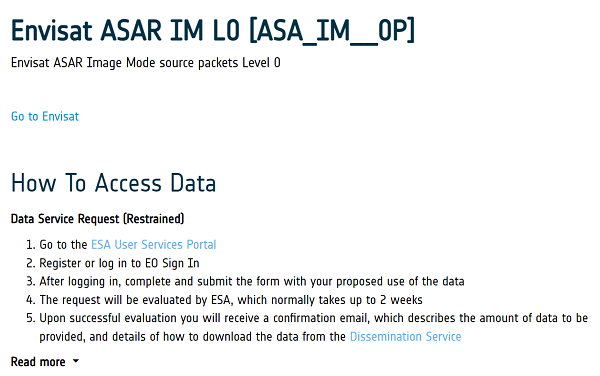- News
- How to request level zero rada...
How to request level zero radar data from ERS and Envisat
05 Dec 2022
To apply to use level zero (A)SAR radar data from ESA’s European Remote Sensing satellites (ERS-1 and ERS-2) and its Envisat mission for research purposes, you should prepare and submit an online form – called a Data Service Request – to put forward your proposed project to ESA for evaluation.
This guide sets out in detail how to complete the process.
View a quick guide to Data Service Request submission in our infographic.
Access to data covered by the Data Service Request process is limited to specific purposes, including testing and development of processors and the processing of level zero data to higher levels.
What is level zero data?
Remote sensing data require meticulous postprocessing to distil usable information on the geophysical parameters of interest from the raw instrument data. Level zero data are unprocessed data at the instrument’s full spatial and temporal resolution. Using supplementary information and analysis techniques, level zero data can be processed sequentially into data products with higher processing levels
1) Browse and Select Relevant Data
A Data Service Request should be prepared to request access to ERS-1/2 and Envisat (A)SAR level zero data, which are distributed for free via ESA’s Heritage Space Programme for selected projects. You can search for data covered by the Data Service Request process by browsing the relevant collections.

You can then use the ‘ESA User Services Portal’ link in the ‘How to Access Data’ section of the dataset description page to begin the Data Service Request process.

2) Sign In or Register
Users with an active ESA EO Sign In account should then use their credentials to log in to the platform and begin filling out the Data Service Request. Users who do not have an account can create one by clicking ‘register now’.
When creating the account, users must read and accept the Terms and Conditions for Utilisation of ESA's Earth Observation data, which apply to the data being requested through the Data Service Request.
Upon registration, users must also agree to ESA's Privacy Policy and the Terms and Conditions for Utilisation of Data under ESA's Third Party Missions Programme.
3) Prepare the Data Service Request
After signing in, you can begin work on the Data Service Request by filling in the required information.

Within the form, you must complete several mandatory fields, including the title of the Data Service Request, primary application domain and study area.
Users are also required to provide a description of the request, outlining the objectives, methods, the expected deliverables and schedule, as well as an explanation of why (A)SAR level zero data are needed as opposed to the existing (A)SAR level one products. This information will form the main basis of ESA’s evaluation of the Data Service Request.
Users can also add optional information – such as tables, list of publications and references – by uploading attachments to the form.
4) Submit Data Service Request
Once the Data Service Request is prepared, submit it to ESA for an internal evaluation. The result of this process is normally provided to the user one to two weeks after submission.
If ESA requires further clarifications related to the Data Service Request, you will be notified by email to provide this information.
You can keep track of the evaluation process by logging into your ESA EO Sign In account and viewing the homepage of the User Services Portal.

After ESA’s decision has been made, you will be notified as to whether the Data Service Request has been accepted or rejected.
If it is approved, you will be provided with instructions on how to access the data, so work on the project can begin.
5) Promote the Results of the Project
When the project is approaching completion, users are encouraged to contact the Earth Online editorial team to discuss the possibility of preparing a Success Story about the research that is featured on the website. The editors can be reached at: contentmatters4earthonline@ejr-quartz.com